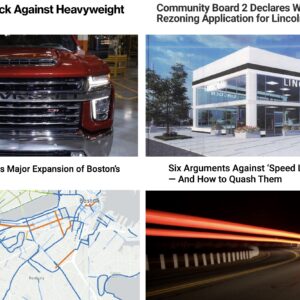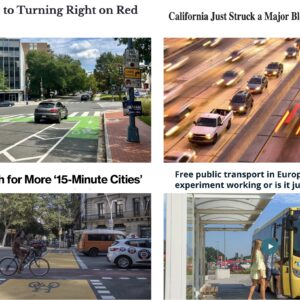Here’s the news that caught our eye this week:
– Organizers guess that 100,000 people turned out on Sunday for CicLAvia, Los Angeles’ first open streets event, where 7.5 miles of streets were opened up for bicycling, walking, and hanging out. Check out this short video with on-the-street interviews and great footage:
– There are a couple of cars out on the freeway today with nobody at the wheel…Google is testing a robotic driving system that will, presumably, free people up to text to their hearts’ content one day.
– Bike advocates are still crunching and pondering the new census commute numbers. Here’s an analysis of Pacific Northwest transportation stats. And here’s one that focuses on the third bikiest city in the nation, behind only Boulder and Eugene (nope, it’s not Portland).
– Are you a cyclist or a person on a bicycle? Is it wrong to use these labels, or is it good for building identity? A transit advocate tackles the question.
– Haters will hate, and bicycling is, sadly, often a target. This editorial addressing the backlash against a proposed cycle track in Vancouver, BC, and this one addressing responses to Maryland’s new bike safety laws, both do a bang-up job refuting the lies and paranoia. And finally, here’s an excellent outline of the current political ins and outs of bicycling in Toronto.
– In NYC, a disgruntled neighbor invites kindred spirits to take a stand against the new 1st Ave bike lane.
– An exploration of the state of bicycling in post-Katrina New Orleans.
– In Tampa, six people have been killed while bicycling in the last two months, and advocates are responding with anger and concern.
– Inspired by recent media focus on cycle chic, one blogger wonders if the emergence of fashionable bicycle clothing is related to an increase in women bicycling.
– In Boston, a new company allows you to make extra cash lending out your car to neighbors who don’t own one of their own.
– If all goes as planned, the first ten houses of Carfree City (previously dubbed Bicycle City) will soon be built in a wooded area in South Carolina.
– A New Zealand inventor has designed a monorail along which individual compartments are transported by pedal power. The first prototype is being built.
– Videos of the week… There are a lot of potential winners in this category, from a clever trick for opening a bottle of wine with a bike pump to a preview of a documentary about Cincinnati’s abandoned subway system, but this this Senegalese man‘s unique feats of balance and grace on his single speed bicycle take the cake for fun and inspiration.






Thanks for reading.
BikePortland has served this community with independent community journalism since 2005. We rely on subscriptions from readers like you to survive. Your financial support is vital in keeping this valuable resource alive and well.
Please subscribe today to strengthen and expand our work.
“cars out on the freeway today with nobody at the wheel”
…the true solution to all our transportation problems. The article points out that the technology is clearly not an obstacle anymore, rather its that the current legal system doesn’t cover this new scenario. Rather than jump on this opportunity and bring the laws up to speed, I’m sure we’ll just let thousands more people die in traffic accidents.
If you weigh the number of traffic accidents caused by mechanical failure vs. human error (which should include things like failure to maintain brakes), you’ll find that mechanical failures are almost negligible. So the problem is the human component. Lets deal with it!
I looked into that pedal-powered monorail system when the company won a major grant from Google.
Unfortunately the system is flawed at its very core as far as being a transportation mechanism. Consider what N Williams would be like with the addition of the unbreakable constraint that you cannot pass anyone, ever.
The more novel applications, amusement parks, jungle tours, etc. sound great though.
“cars out on the freeway today with nobody at the wheel”:
It’s not just accident reduction that would benefit, but traffic flow as well. If the routing and movement of all cars on Portland Metro highways were remote regulated, all the un-necessary lane changing and speeding could be eliminated.
I hope that these robotic driving systems price everyone out of manual driving.
By that I mean not that you won’t have an automobile but that your insurance company will charge everyone exorbinant fees for every single minute and mile that is not driven by a proven safe robotic system.
Remember that having your own car is less about the actual driving then it is about the freedom to leave and arrive whenever you want.
Surely there will be be people who want to drive. I suggest a insurance or government mandated driving school on par with a racing (NASCAR?) or a tactical driving school to ensure that drivers are more skilled than the average robotic system.
After all that if someone manually driving kills or injures someone there is no hardship argument against taking away their driving license: the robot can drive.
My biggest concern is not Skynet taking control of the roads (go see the comments at the Engadget page http://goo.gl/tfFL for this story and a laugh) but how organic travel modes (cycling and walking) might be legally marginalized when automated systems allow fast dense travel. Any system flow aberration caused by something like a drunk pedestrian or a randomly weaving cyclist could cause major delays.
But ANYTHING is better than distracted and aggressive human drivers.
wsbob #3
Think big:
With discreet traffic management of over 80% of all motorized traffic you can reduce all speeds to within +5MPH of the average trip speed by reducing or eliminating the need to stop at all.
Active reroute of all traffic away from crashes and break downs with the system actively managing traffic down dozens of secondary routes so as to not overload each of those.
Individually these robotic cars will behave, well, robotically but as a whole a mass of vehicles will behave more a water flowing smoothly towards a destination following the path of least resistance rather than a stampede of cattle trying to crush through a gate.
Since Portland is such a DIY city, I’m surprised that the car lending program has not started here in some fashion. And if it has please point me where to sign up.
To 6:
Several neighborhoods – amongst them Sunnyside- were thinking about it, but refrained due to clauses in car insurance policies…
q`Tzal …”…With discreet traffic management of over 80% of all motorized traffic you can reduce all speeds to within +5MPH of the average trip speed by reducing or eliminating the need to stop at all. …”.
Sounds great. With internal combustion engines, especially during traffic jams, the am/pm commutes are the worst for pollution and fuel waste. During those hours, having all motor vehicles travel at uniform speeds could possibly resolve lots of problems.
As long as we’re dreaming, how about commute highways having power that cars with electric motors could grab onto instead of drawing from on-board batteries? Something like that could ease ‘range anxiety’, and be an incentive to buy electric cars.
That gets back to the reality of generating the electricity to do something like that…coal generation, nuclear plants, ugly solar arrays and wind turbines, hydro dams.
Better, if more people would live closer to their jobs so they could walk and bike to them, eliminating some of the need for such a major motor vehicle commute every day.